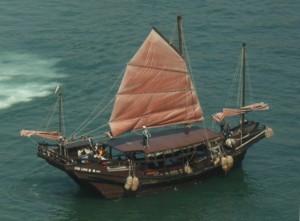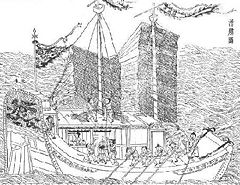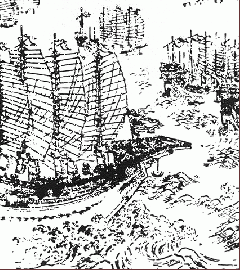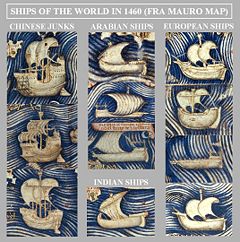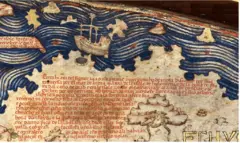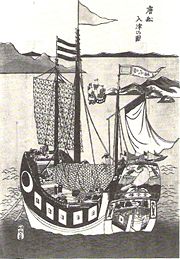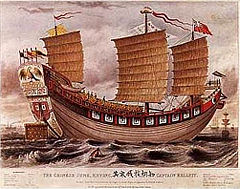Junk (ship)
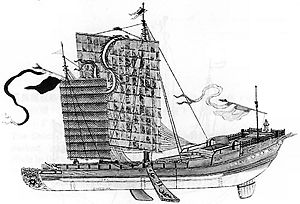
A junk is a Chinese sailing vessel. The English name comes from Javanese djong (Malay: adjong), meaning 'ship' or 'large vessel'. Junks were originally developed during the Han Dynasty (220 B.C.E.–200 C.E.) and further evolved to represent one of the most successful ship designs in history. Junks were used both for military combat and for trade, traveling long distances on rough inland rivers and at across the sea. Numerous accounts by early Chinese historians and by medieval travelers describe the junks and attest to their size and efficiency.
Junks incorporated numerous technical advances in sail plan and hull designs that were later adopted in Western shipbuilding. The sails were rigged so that they could direct wind into each other, allowing the junks to sail into the wind and to travel in heavy winds and rough seas. Multiple compartments were built in the hull, accessed by separate hatches and ladders, and similar in structure to the interior of a bamboo stem. These could be made watertight to slow flooding, but the front compartments often had “limber holes” that allowed water to enter and leave the compartment, helping to ballast the ship in rough waters. Junks employed stern-mounted rudders centuries before their adoption in the West, though the rudder, origin, form and construction was completely different. Around the thirteenth to the fifteenth centuries, many junks incorporated "fenestrated rudders" (rudders with holes in them), to lessen the force needed to direct the steering of the rudder. Leeboards and centerboards, used to stabilize the junk and to improve its capability to sail upwind, were adopted by Portuguese and Dutch ships around 1570.
Other innovations included square-pallet bilge pumps, which were adopted by the West during the fifteenth century, and the use of the compass for navigational purposes.
Etymology
The English name, “junk,” comes from Javanese djong (Malay: adjong), meaning 'ship' or 'large vessel'. The word came into English from both Portuguese junco and Dutch jonk. The Chinese name for a junk is either 中国帆船 (pinyin: Zhōngguó fānchuán, lit. 'Chinese clipper') or 戎克船 (róngkè chuán, lit. 'battleship'). The character 船 (chuán) may be the origin of the word 'junk', from the Min Nan (Hokkien) pronunciation, chun5. [1]
Design
Junks are efficient and sturdy ships that were traveling across oceans as early as the second century C.E.. They incorporated numerous technical advances in sail plan and hull designs that were later adopted in Western shipbuilding.
The historian H. Warington Smith considered the junk one of the most efficient ship designs:
As an engine for carrying man and his commerce upon the high and stormy seas as well as on the vast inland waterways, it is doubtful if any class of vessel is more suited or better adapted to its purpose than the Chinese or Indian junk, and it is certain that for flatness of sail and handiness, the Chinese rig is unsurpassed. [2]
Sail Plan
The structure and flexibility of junk sails make the junk easy to sail, and fast. Unlike the sails of a traditional square rigged ship, the sails of a junk can be moved inward, toward the long axis of the ship, allowing the junk to sail into the wind. The sails include several horizontal members ("battens") which provide shape and strength. Junk sails are controlled at their trailing edge by lines, much in the same way as the mainsail on a typical sailboat, however, in the junk sail each batten has a line attached to its trailing edge; on a typical sailboat this line (the sheet) is attached only to the boom. The sails can also be easily reefed and adjusted for fullness, to accommodate various wind strengths. The battens make the sails more resistant than traditional sails to large tears, as a tear is typically limited to a single "panel" between battens. Junk sails have much in common with the most aerodynamically efficient sails used today in windsurfers or catamarans, although their design can be traced back as early the third century C.E.
The standing rigging is simple or absent.
The sail-plan is also spread out among multiple masts, allowing for a powerful sail surface, and a good repartition of efforts. The rig allows for good sailing into the wind.
Flags were hung from the masts to bring good luck to the sailors on board. A legend among the Chinese regarded a dragon which lived in the clouds. It was said that when the dragon became angry, it created typhoons and storms. Bright flags, with Chinese writing on them, were said to please the dragon; red was the best color, as it would make the dragon likely to help the sailors.
Hull design
Classic junks were built of softwoods (though in Guangdong they were made with teak) with multiple compartments accessed by separate hatches and ladders, similar in structure to the interior of a bamboo stem. The largest junks were built for world exploration in the 1400s, and were around 120 (400+ feet) meters in length. (See Zheng He)
Rudders
Junks employed stern-mounted rudders centuries before their adoption in the West, though the rudder, origin, form and construction was completely different. It was an innovation which permitted the steering of large, high-freeboard ships, and its well-balanced design allowed adjustment according to the depth of the water. A sizable junk could have a rudder that required to three members of the crew to control it in strong weather. The world's oldest known depiction of a stern-mounted rudder can be seen on a pottery model of a junk dating from the 100s C.E., though some scholars think this may have been a steering oar, because the model is of a river boat that may have been towed or poled. By contrast, the West's oldest known stern-mounted rudder can be found in church carvings dating to around 1180 C.E.
Beginning sometime during the thirteenth to the fifteenth centuries, many junks incorporated "fenestrated rudders" (rudders with holes in them), an innovation adopted in the West in 1901 to decrease the vulnerability of torpedo boats' rudders when maneuvering at high speed. The Chinese discovery was probably adopted to lessen the force needed to direct the steering of the rudder.
The rudder is reported to be the strongest part of the junk. In the Tiangong Kaiwu ("Exploitation of the Works of Nature") (1637), Song Yingxing wrote, "The rudder-post is made of elm, or else of langmu or of zhumu. " The Ming author also applauded the strength of the langmu wood, saying that it was as "if one could use a single silk thread to hoist a thousand jun or sustain the weight of a mountain landslide."
Separate compartments
The interior compartments of the hull reinforced the structure of the ship and reduced the rapidity of flooding in case the hull was breached. Ships built in this manner were written of in Zhu Yu's book Pingzhou Table Talks, published by 1119 C.E. during the Song Dynasty.[3] This type of construction for Chinese ship hulls was attested to by the Moroccan Muslim Berber traveler Ibn Batutta (1304-1377 C.E.), who described it in great detail. [4] Although some historians have questioned whether the compartments were watertight, most believe that watertight compartments did exist in Chinese junks. All wrecks discovered so far have limber holes; these are located only in the foremost and aftermost compartments.
Benjamin Franklin wrote in a 1787 letter on the project of mail packets between the United States and France:
As these vessels are not to be laden with goods, their holds may without inconvenience be divided into separate apartments, after the Chinese manner, and each of these apartments caulked tight so as to keep out water. (Benjamin Franklin, 1787).
In 1795, Sir Samuel Bentham, inspector of dockyards of the Royal Navy, and designer of six new sailing ships, argued for the adoption of "partitions contributing to strength, and securing the ship against foundering, as practiced by the Chinese of the present day." His idea was not adopted. Bentham had been in China in 1782, and he acknowledged that he had got the idea of watertight compartments by looking at Chinese junks there. Bentham was a friend of Isambard Brunel, so it is possible that he had some influence on Brunel's adoption of longitudinal, strengthening bulkheads in the lower deck of the SS Great Britain.
Due to the numerous foreign primary sources that hint to the existence of true watertight compartments in junks, historians such as Joseph Needham proposed that the limber holes were stopped up during leakage. He addresses this issue in pg 422 of Science and Civilisation in Ancient China:
Less well known is the interesting fact that in some types of Chinese craft the foremost (and less frequently also the aftermost) compartments is made free-flooding. Holes are purposely contrived in the planking. This is the case with the salt-boats which shoot the rapids down from Tzuliuching in Szechuan, the gondola-shaped boats of the Poyang Lake, and many sea going junks. The Szechuanese boatmen say that this reduces resistance to the water to a minimum, and the device must certainly cushion the shocks of pounding when the boat pitches heavily in the rapids, for she acquires and discharges water ballast rapidly just at the time when it is most desirable to counteract buffeting at stem and stern. The sailors say that it stops junks flying up into the wind. It may be the reality at the bottom of the following story, related by Liu Ching-Shu of the +5th century, in his book I Yuan (Garden of Strange Things):
In Fu-Nan (Cambodia) gold is always used in transactions. Once there were (some people who) having hired a boat to go from east to west near and far, had not reached their destination when the time came for the payment of the pound (of gold) which had been agreed upon. They therefore wished to reduce the quantity (to be paid). The master of the ship then played a trick upon them. He made (as it were) a way for the water to enter the bottom of the boat, which seemed to be about to sink, and remained stationary, moving neither forward nor backward. All the passengers were very frightened and came to make offerings. The boat (afterwards) returned to its original state.
Leeboards and centerboards, used to stabilize the junk and to improve its capability to sail upwind, are documented from a 759 C.E. book by Li Chuan. This innovation was adopted by Portuguese and Dutch ships around 1570.
Other innovations included the square-pallet bilge pumps, which were adopted by the West during the fifteenth century. Junks also relied on the compass for navigational purposes.
This, however, would seem to have involved openings which could be controlled, and the water pumped out afterwards. This was easily effected in China (still seen in Kuangtung and Hong Kong), but the practice was also known in England, where the compartment was called the 'wet-well', and the boat in which it was built, a 'well-smack'. If the tradition is right that such boats date in Europe from +1712 then it may well be that the Chinese bulkhead principle was introduced twice, first for small coastal fishing boats at the end of the seventeenth century, and then for large ships a century later.
Leeboards and centerboards
Leeboards and centerboards, used to stabilize the junk and to improve its capability to sail upwind, are documented from a 759 C.E. book by Li Chuan, and were adopted by Portuguese and Dutch ships around 1570.
Other innovations included the square-pallet bilge pumps, which were adopted by the West during the sixteenth century. Junks also relied on use of the magnetic compass for navigational purposes.
History
The first records of junks can be found in references dating to Han Dynasty (220 B.C.E.-200 C.E.).
Second century Junks (Han Dynasty)
The third century book "Strange Things of the South" (南州異物志) by Wan Chen (萬震) describes junks capable of carrying 700 people together with 260 tons of cargo ("more than 10,000 "斛"). He explains the ship's design as follows:
The four sails do not face directly forward, but are set obliquely, and so arranged that they can all be fixed in the same direction, to receive the wind and to spill it. Those sails which are behind the most windward one receiving the pressure of the wind, throw it from one to the other, so that they all profit from its force. If it is violent, (the sailors) diminish or augment the surface of the sails according to the conditions. This oblique rig, which permits the sails to receive from one another the breath of the wind, obviates the anxiety attendant upon having high masts. Thus these ships sail without avoiding strong winds and dashing waves, by the aid of which they can make great speed" ("Strange Things of the South," Wan Chen, from Robert Temple).
A 260 C.E. book by Kang Tai (康泰) also described ships with seven masts, traveling as far as Syria.
Tenth - Thirteenth century Junks (Song Dynasty)
The great trading dynasty of the Song employed junks extensively. The naval strength of the Song, both mercantile and military, became the backbone of the naval power of the following Yuan dynasty. In particular the Mongol invasions of Japan (1274-1284), as well as the Mongol invasion of Java, essentially relied on recently acquired Song naval capabilities. The ship to the right's dimensions are 360'x 110'x 120'.
Fourteenth century Junks (Yuan Dynasty)
The enormous dimensions of the Chinese ships of the Medieval period are described in Chinese sources, and are confirmed by Western travelers to the East, such as Marco Polo, Ibn Battuta and Niccolò da Conti. According to Ibn Battuta, who visited China in 1347:
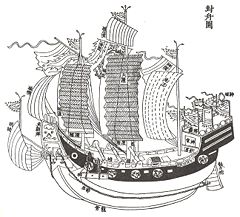
… We stopped in the port of Calicut, in which there were at the time thirteen Chinese vessels, and disembarked. On the China Sea traveling is done in Chinese ships only, so we shall describe their arrangements. The Chinese vessels are of three kinds; large ships called chunks (junks), middle sized ones called "zaws" (dhows) and the small ones kakams. The large ships have anything from twelve down to three sails, which are made of bamboo rods plaited into mats. They are never lowered, but turned according to the direction of the wind; at anchor they are left floating in the wind.
A ship carries a complement of a thousand men, six hundred of whom are sailors and four hundred men-at-arms, including archers, men with shields and crossbows, who throw naphtha. Three smaller ones, the "half," the "third" and the "quarter," accompany each large vessel. These vessels are built in the towns of Zaytun (Zaitun; today's Quanzhou; 刺桐) and Sin-Kalan. The vessel has four decks and contains rooms, cabins, and saloons for merchants; a cabin has chambers and a lavatory, and can be locked by its occupants.
This is the manner after which they are made; two (parallel) walls of very thick wooden (planking) are raised and across the space between them are placed very thick planks (the bulkheads) secured longitudinally and transversely by means of large nails, each three ells in length. When these walls have thus been built the lower deck is fitted in and the ship is launched before the upper works are finished. (Ibn Battuta).
Fifteenth-Seventeenth century Junks (Ming Dynasty)
Expedition of Zheng He
The largest junks ever built were probably those of Admiral Zheng He, for his expeditions in the Indian Ocean. According to Chinese sources, the fleet comprised 30,000 men and over 300 ships at its height. The 1405 expedition consisted of 27,000 men and 317 ships. The dimensions of the Zheng He's ships according to ancient Chinese chronicles and disputed by skeptical modern scholars (see below):
- "Treasure ships", used by the commander of the fleet and his deputies (Nine-masted junks, about 400 feet long and 160 feet wide).
- "Horse ships", carrying tribute goods and repair material for the fleet (Eight-masted junks, about 339 feet long and 138 feet wide)
- "Supply ships", containing food-staple for the crew (Seven-masted junks, about 257 feet long and 115 feet wide).
- "Troop transports" (Six-masted junks, about 220 feet long and 83 feet wide).
- "Fuchuan warships" (Five-masted junks, about 165 feet long).
- "Patrol boats" (Eight-oared, about 120 feet long).
- "Water tankers", with one month supply of fresh water and sustainability.
Recent research, however, suggests that the actual length of the biggest treasure ships may have rather lain between 59 m and 84 m.[5] In later historical periods, wooden ships approaching this size, such as HMS Orlando (1858), were unwieldy and visibly undulated with the waves, even with steel braces in the hull. The problem of "hogging," the tendency of the largest wooden ships to sag (like a pig's body) because of buoyancy in the middle, would have been impossible to solve. The length-to-width ratio of 2.47 is not well suited for fast navigation on the oceans. Hydrodynamic models have proved that ships with such dimensions are unsailable in open seas.
Accounts of Medieval travelers
Niccolò da Conti in his relations of his travels in Asia between 1419 and 1444, matter-of-factly describes huge junks of about 2,000 tons:
They make ships larger than ours, about 2,000 tons in size, with five sails and as many masts. The lower part is made of three decks, so as to better resist storms, which occur frequently. These ships are separated into several compartments, so that if one is touched during a storm, the others remain intact." (Niccolò da Conti)[6]
Also, in 1456, the Fra Mauro map described the presence of junks in the Indian Ocean as well as their construction:
The ships called junks (lit. "Zonchi") that navigate these seas carry four masts or more, some of which can be raised or lowered, and have 40 to 60 cabins for the merchants and only one tiller. They can navigate without a compass, because they have an astrologer, who stands on the side and, with an astrolabe in hand, gives orders to the navigator. (Text from the Fra Mauro map, 09-P25.)[7]
Fra Mauro further explains that one of these junks rounded the Cape of Good Hope and traveled far into the Atlantic Ocean, in 1420:
- "About the year of Our Lord 1420 a ship, what is called an Asian junk (lit. "Zoncho de India"), on a crossing of the Sea of India towards the "Isle of Men and Women," was diverted beyond the "Cape of Diab" (Shown as the Cape of Good Hope on the map), through the "Green Isles" (lit. "isole uerde," Cabo Verde Islands), out into the "Sea of Darkness" (Atlantic Ocean) on a way west and southwest. Nothing but air and water was seen for 40 days and by their reckoning they ran 2,000 miles and fortune deserted them. When the stress of the weather had subsided they made the return to the said "Cape of Diab" in 70 days and drawing near to the shore to supply their wants the sailors saw the egg of a bird called roc, which egg is as big as an amphora." (Text from Fra Mauro map, 10-A13.)[8]
Asian trade
Chinese junks were used extensively in Asian trade during the sixteenth and seventeenth centuries, traveling especially to Japan, where they competed with Japanese Red Seal Ships, Portuguese carracks and Dutch galleons, and to Southeast Asia. Richard Cocks, the head of the English trading factory in Hirado, Japan, recorded that 50 to 60 Chinese junks visited Nagasaki in 1612 alone.
These junks were usually three-masted, and averaging between 200 and 800 tons in size, the largest ones having around 130 sailors, 130 traders and sometimes hundreds of passengers.
Nineteenth century (Qing Dynasty)
Junks remained considerable in size and played a key role in Asian trade until the nineteenth century. One of these junks, named Keying, sailed from China around the Cape of Good Hope to the United States and England between 1846 and 1848.
Twentieth century
In 1955, six young men sailed an old Chinese junk from Formosa (Taiwan) to San Francisco. The four month journey aboard the Free China was captured on film, and their arrival into San Francisco made international front-page news. The five Chinese-born friends had seen an advertisement for an international trans-Atlantic yacht race, and jumped at the opportunity for adventure. They were joined by the then U.S. Vice-Consul to Taiwan, who was credited with capturing the courageous journey on film. Enduring typhoons and mishaps, the crew, who had never sailed a century-old junk before, learned along the way. The crew included Reno Chen, Paul Chow, Loo-chi Hu, Benny Hsu, Calvin Mehlert and were led by skipper Marco Chung. After a journey of 6,000 miles, the Free China and her crew arrived into San Francisco Bay under a majestic fog on August 8, 1955. The historic journey was featured on ABC television's "Bold Journey" travelogue.[9]
In 1968, Bill King sailed a junk schooner in the controversial Sunday Times Golden Globe Race.
Notes
- ↑ The word came into English from both Portuguese junco and Dutch jonk. The Chinese name for a junk is either 中国帆船 (pinyin: Zhōngguó fānchuán, lit. 'Chinese clipper') or 戎克船 (róngkè chuán, lit. 'battleship'). The character 船 (chuán) may be the origin of the word 'junk', from the Min Nan (Hokkien) pronunciation, chun5.
- ↑ H. Warington Smith. Mast and Sail in Europe and Asia: Chapter XII. (London: John Murray, 1906) online MAST & SAIL IN EUROPE AND ASIA • CHAPTER XII. Retrieved November 22, 2007.
- ↑ Needham, Volume 4, Part 3, 463.
- ↑ Needham, Volume 4, Part 3, 469.
- ↑ Sally K. Church. The Colossal Ships of Zheng He: Image or Reality? (155-176) "Zheng He; Images & Perceptions." In: South China and Maritime Asia 15,; Hrsg: Roderich Ptak, and Thomas O. Höllmann. (Wiesbaden: Harrasowitz Verlag, 2005)
- ↑ Niccolò da Conti. Le Voyage aux Indes. Chandeigne (ed.), (2004) (in French)
- ↑ Fra Mauro map, 09-P25 original Italian: "Le naue ouer çonchi che nauegano questo mar portano quatro albori e, oltra de questi, do' che se può meter e leuar et ha da 40 in 60 camerele per i marchadanti e portano uno solo timon; le qual nauega sença bossolo, perché i portano uno astrologo el qual sta in alto e separato e con l'astrolabio in man dà ordene al nauegar" MAPPAMONDO DI FRA MAURO / FRA MAURO WORLD MAP. Retrieved November 22, 2007.
- ↑ Text from Fra Mauro map, 10-A13 , original Italian: "Circa hi ani del Signor 1420 una naue ouer çoncho de india discorse per una trauersa per el mar de india a la uia de le isole de hi homeni e de le done de fuora dal cauo de diab e tra le isole uerde e le oscuritade a la uia de ponente e de garbin per 40 çornade, non trouando mai altro che aiere e aqua, e per suo arbitrio iscorse 2000 mia e declinata la fortuna i fece suo retorno in çorni 70 fina al sopradito cauo de diab. E acostandose la naue a le riue per suo bisogno, i marinari uedeno uno ouo de uno oselo nominato chrocho, el qual ouo era de la grandeça de una bota d'anfora." MAPPAMONDO DI FRA MAURO / FRA MAURO WORLD MAP. Retrieved November 22, 2007.
- ↑ Charles W. Cushman Photograph Collection, The Trustees of Indiana University. Retrieved November 22, 2007.
ReferencesISBN links support NWE through referral fees
- Da Conti, Niccolò. Chandeigne (ed.), Le voyage aux Indes. (in French), 2004, ISBN 2906462861
- Hornell, James. 1922. The origin of the Chinese junk and sampan. S.l: s.n.
- Maitland, Derek, and Nik Wheeler. 1981. Setting sails a tribute to the Chinese junk. Hongkong: Publications Division, South China Morning Post.
- Needham, Joseph, and Ling Wang. 1954. Science and civilisation in China, Vol. 4. Cambridge [Eng.]: University Press. ISBN 052132727X
- Temple, Robert K. G., and Joseph Needham. 1986. The genius of China 3,000 years of science, discovery, and invention. New York: Simon and Schuster. ISBN 0671620282
- Turnbull, Stephen R., and Wayne Reynolds. 2002. Fighting ships of the Far East. 1, China & Southeast Asia 202 B.C.E. - AD 1419. New Vanguard, 61. Oxford: Osprey. ISBN 1841763861 *Worcester, G. R. G. 1966. Sail and sweep in China the history and development of the Chinese junk as illustrated by the collection of junk models in the Science Museum. London: H.M.S.O.
Credits
New World Encyclopedia writers and editors rewrote and completed the Wikipedia article in accordance with New World Encyclopedia standards. This article abides by terms of the Creative Commons CC-by-sa 3.0 License (CC-by-sa), which may be used and disseminated with proper attribution. Credit is due under the terms of this license that can reference both the New World Encyclopedia contributors and the selfless volunteer contributors of the Wikimedia Foundation. To cite this article click here for a list of acceptable citing formats.The history of earlier contributions by wikipedians is accessible to researchers here:
The history of this article since it was imported to New World Encyclopedia:
Note: Some restrictions may apply to use of individual images which are separately licensed.
